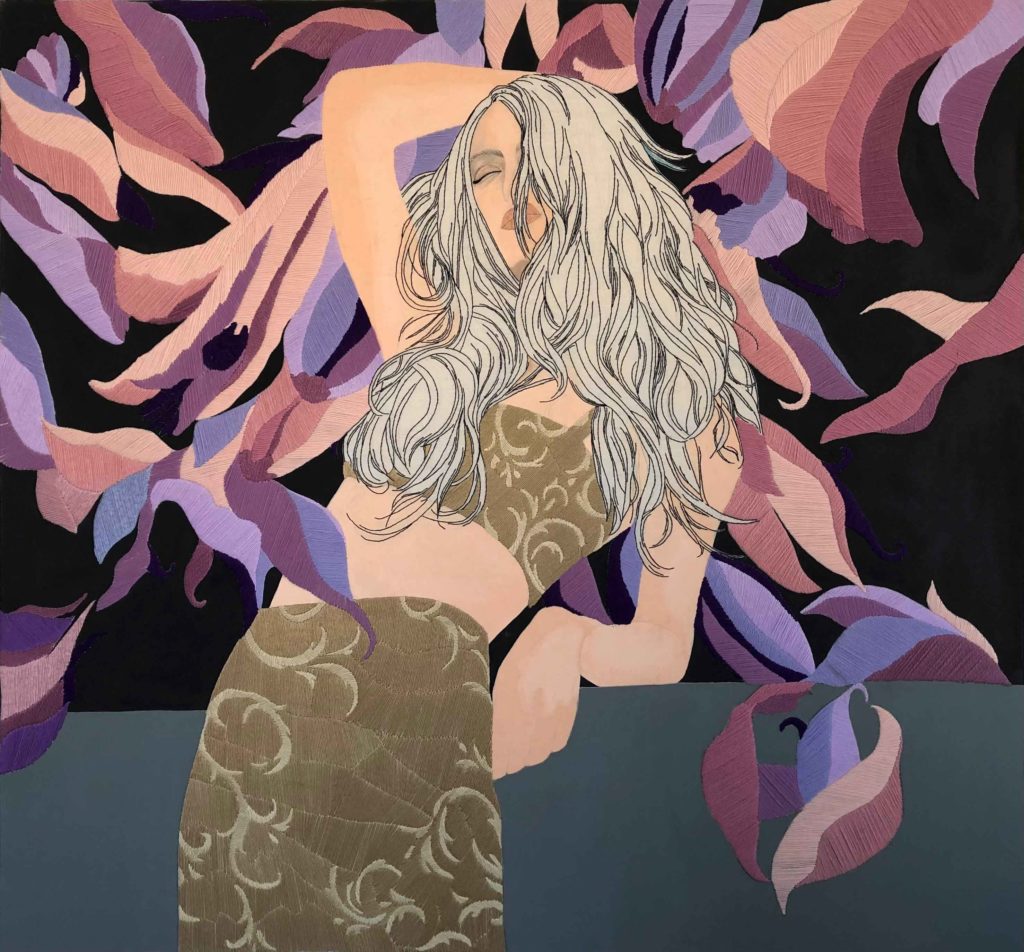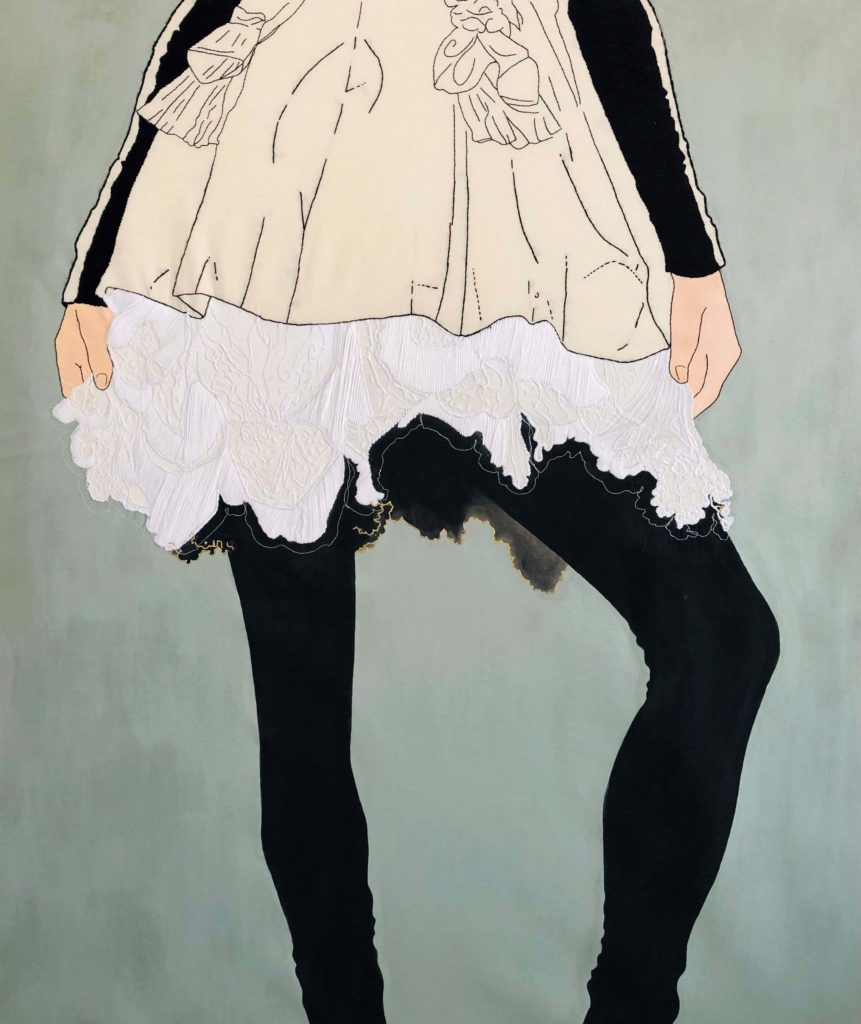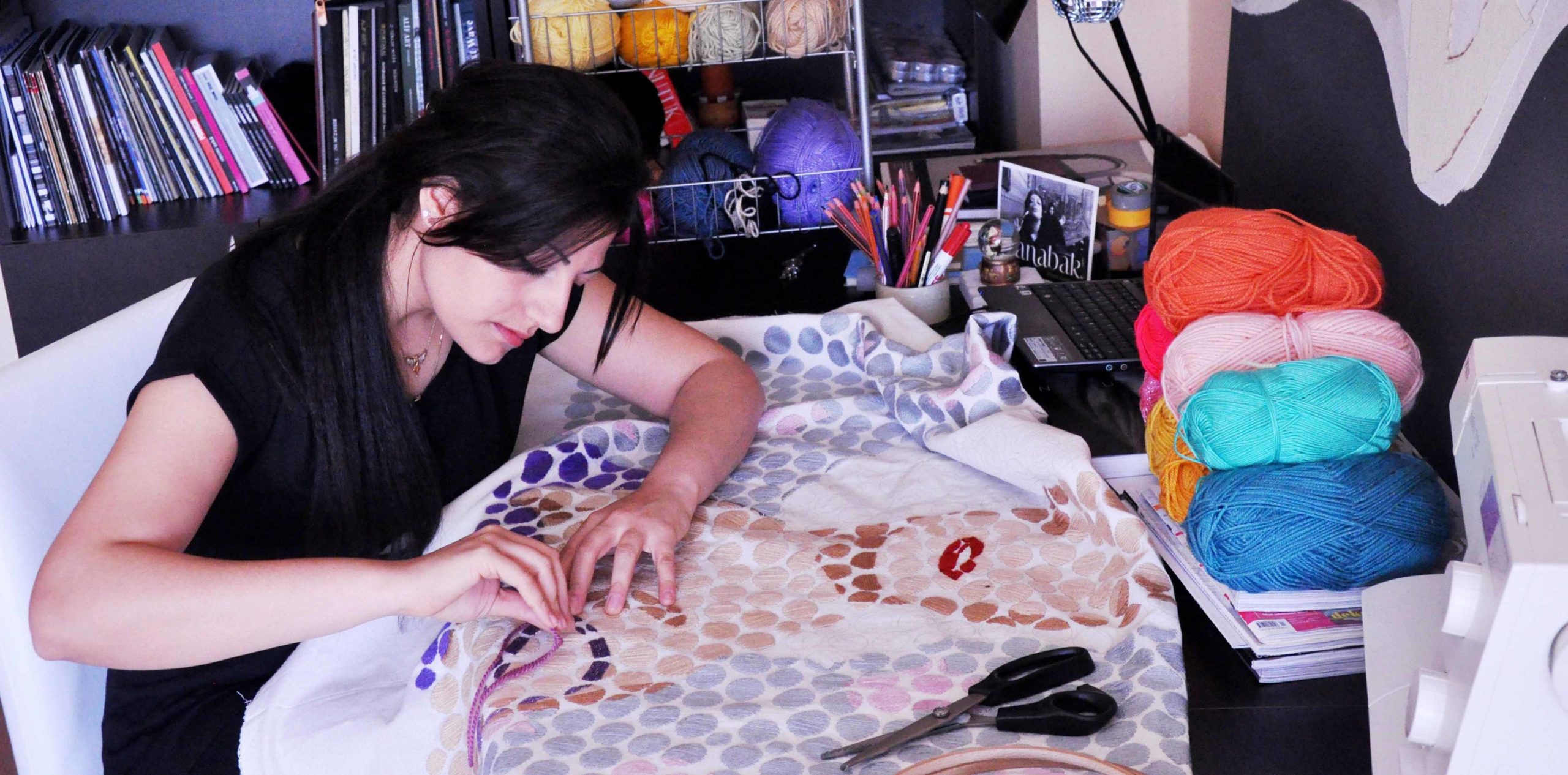Funda Alkan’s art practice, built around cutting, sewing, and embroidery techniques, includes a critique of the perceptions of mainstream beauty imposed on women by society. Shaping her artistic journey with the stories and inner inspirations she encounters, Alkan references historical tragedies and social traditions that are closely related to the female body in her works.
Funda Alkan, has completed her undergraduate education at Dokuz Eylül University, Buca Education Faculty, Painting Department, and continued her graduate studies at Dokuz Eylül University Fine Arts Faculty Painting Department. We had a pleasant conversation with the artist about the topics and artists that inspired her works, the judgmental and demeaning gaze on the female body, and the current developments in the art world.
In your works, we often see that you use tools such as needles, thread, and scissors to express yourself. How did you discover your interest and skill in your artistic journey to use techniques such as cutting, pasting, sewing, and embroidery?
Ever since I was a child, I used to watch my mother sewing all the time. I think my acquaintance with the material, my interest, and my curiosity was formed during those years. Afterward, I realized that just using paint as a material seemed not enough for me in my paintings. The fact that these materials add three dimensions to my paintings, how they contain a strong expression, and the pleasure I get while working with them are among the reasons why I prefer using them.
You heavily focus on the pressures, violence, and unattainable expectations that get appointed to the female body in your works. What were the reasons that led you to concentrate on this field? Can we talk about a turning point that has shaped your practice?
The topic I chose for my master’s thesis is ‘Louise Bourgeois and her art in the context of femininity, gender and feminism’. Following this path, I was also influenced by other artists in the process of my research and readings. After reading Tracey Emin’s book Wild Vatan during my research, these researches became important parts of my production process rather than being a thesis topic for me. The concepts of loneliness and vulnerability in traumatic lives and the reasons they exist became my sources of inspiration and have evolved in line with these kinds of research in my own work. To conclude, we can say that my thesis position and my researches in those years were a turning point in shaping my practice as an artist.

You use your sewing skill, which is often associated with femininity, and then in your works, you criticize the same gender system that associates femininity with sewing. What do you think about the relationship of your technique with the subjects you cover? Can cutting, sewing and pasting be read as metaphors representing the perception of beauty “created” for the female body?
In fact, there exists a different aspect of the sewing skill in femininity. In the first works, I used these materials and I interpreted the cutting, sewing, sticking, and stretching actions as plastic surgeries. In my works, I focus on the concepts of beauty that society imposes on women and their bodies. I reflect on the social pressures that marginalize women and construct them as an independent identity, the psychological and physical changes of the violence that the female body is voluntarily or involuntarily subjected to, and the pressure to look perfect, which drags most women to the search for a suitable body, in my works it is reflected by cutting, pasting and sewing.
Instead of assigning a fixed identity to the female figures you are dealing with, you choose to abstract them to a certain extent or to focus on certain parts of their bodies. What are the reasons behind this approach?
This situation depends on the works I produce within my series. In the processes before 2010, I was working on sections of the female body with the “patchwork” technique. Between 2010 and 2012, I worked on iconic female portraits. Afterward, while I was researching the persecution of women for the sake of beauty in the historical process, I was mostly influenced by the French corset and created my second personal exhibition on this subject by concentrating on the history of the corset because it actually dates back to the 200’s BC. In the 16th century, when the queen of England stated that she did not want to see a wide and sagging waist in the palace, corsets began to be used and in the reign of Elizabeth I, they started to be produced from whalebone to be strong. In one of the articles I read, women were trained to breathe in it at dinner parties. At an invitation, a woman’s corset breaks and stabs her in her liver. This affected me a lot. Another case is the Lotus foot. A practice that disfigures the feet by preventing them from growing, under the Chinese tradition of ‘looking beautiful’ for young children. Today, we are still witnessing the persecution of women through various practices. Historical tragedies and social traditions like this inspire me.
Corsets, heels, and laces are among the symbols we frequently encounter in your works, but we can observe a lot more abstract compositions. You also have works such as “The Emptiness”. How do you position your abstract works in your practice and what meanings do they have for you?
I usually produce series as works within the framework of the subjects, stories, and events that I am influenced by. Among these, abstract works come out during the periods where I let them have a voice. The work called “Space” is one of them. I started from the feeling of emptiness in crowds, noise, and density. This production process is purely instinctive. A dream I had, the music I listened to, a frame from the movies I watched, the feeling of a street I passed; almost everything can create interaction and enable me to produce these abstract works. They have a different world.

We see the traces of approaches such as Pointillism, Pop-Art and Abstract Figurative in your works. Who were the artists who influenced you in your multi-layered practice? Which artists’ works do you follow closely at the moment?
I attach great importance to the originality of my work. For example, in the portrait series I produced with polka dot embroidery, I created that technique as a result of my own experiences. While producing solutions to the difficulties that I encounter during the production phase, the technique is already taking shape by itself. Also, some of the artists I follow are Cayce Zavaglia, Ghada Amer, Maryam Ashkanian, Tansy Hargan, Sabatina Leccia…
How do you interpret the relationship of your works with “Textile Art”? We started to hear the names of textile artists more frequently in fairs, gallery representations, large-scale exhibitions and museum collections. What do you think about the current rise of “Textile Art”?
Today, while observing the art of textile; it is possible to see that it has become an open space for new ideas and creativity with the existence of contemporary art movements, social events, cultural differences, communication, and interaction.
Actually, I cannot describe my works as textile art. Yes, I use textile materials, I also use paint, I can use anything I can express myself comfortably as a material. I love the variety of materials. Since my working process takes a long time due to technical reasons, it is a laborious but exciting and meditation-effective process that requires a lot of patience. If I were to interpret the recent rise and popularity of textile art from my own perspective; I can say that material diversity with strong expression possibilities, experimental searches, and the magical world of materials that give pleasure with traditional feelings, becoming a means of expression in the field of art.
How did the pandemic process go for you in terms of production? When creating new works, do you need to reach deep within yourself to look for inspiration or do you follow different stories?
I can say that while my process is badly affected by the pandemic process in every sense, it also had some positive effects. It created a copious process of thinking, working, reading and producing. When producing new works, I usually turn to myself, but I also let the stories drag me. For me, everything should flow in a spontaneous harmony.
As an artist, what do you think about experiencing art through online platforms? How does it make you feel that your works will meet with art lovers through Art50.net?
I was not very keen on the idea of being on an online platform. But I am very happy to be a part of this platform, whose name I hear all the time, my friends also take part in it, and I am sure of its discipline and reliability. It excites me that my works meet the audience through this platform, which values art and artists, has a quality line in the cultural sense, and cares not only for sales but also for the visibility of the artist. Thank you ART50 for your interest and good support.
You can access Funda Alkan’s works on Art50.net here.

